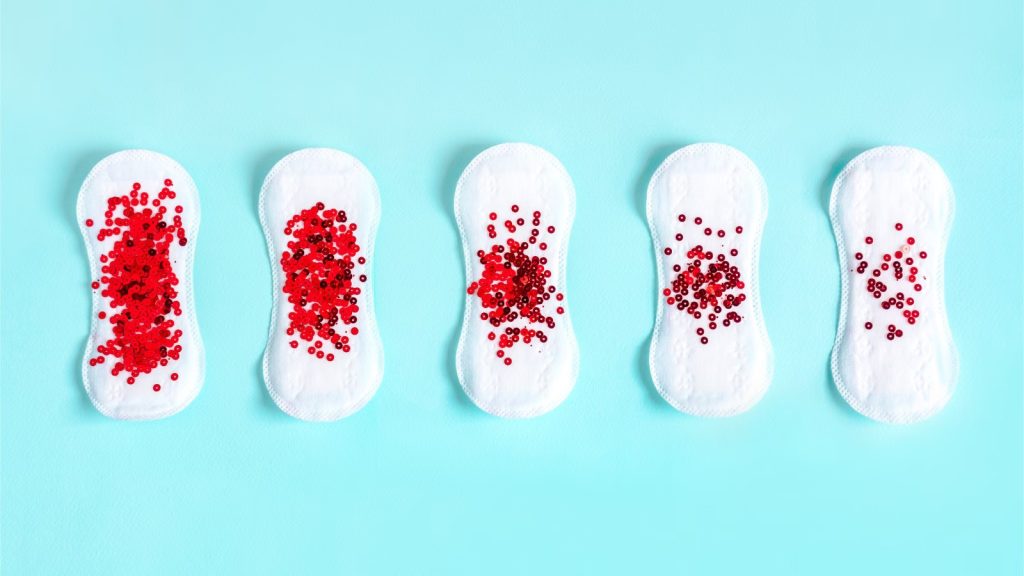
Menstrual health remains an essential aspect of women’s well-being, even though it is often underrepresented in mainstream medical discourse. Among the phenomena observed during menstruation, blood clots—gelatinous masses expelled alongside the flow—have garnered increasing attention due to their potential link to the severity of cramps and other associated discomforts. Blood clots during periods have different levels, meaning, depending on their thickness, which makes it important for women to pay close attention to their flow and every change or anomaly they may experience or notice.
Menstruation and Blood Clots
Menstrual clots are typically formed when the uterine lining sheds and mixes with blood, mucus, and tissue. These clots are a natural part of menstruation for many individuals. However, their size, frequency, and texture can vary, sometimes correlating with severe dysmenorrhoea (painful cramps). The biological basis of this connection lies in prostaglandins, hormone-like substances that stimulate uterine contractions to expel the menstrual lining. Excessive clotting can increase uterine resistance, intensifying these contractions and, subsequently, the pain experienced.
Clots smaller than 2.5 cm (approximately the size of a 10p coin) and occurring infrequently are generally considered normal. However, clots larger than this or those accompanied by heavy menstrual bleeding (menorrhagia), dizziness, or fatigue may signal underlying conditions such as uterine fibroids, endometriosis, or polycystic ovary syndrome (PCOS). If clots consistently exceed this size, occur frequently, or are associated with significant pain or other concerning symptoms, it is advisable to consult a GP for further evaluation.
Recent Developments in Research and Treatment
The last decade has witnessed remarkable advancements in understanding the role of menstrual clots in reproductive health. Notable studies have investigated the biochemical composition of clots, revealing their rich fibrin content, akin to those found in thrombotic disorders. This discovery has prompted a closer examination of coagulation factors and their potential therapeutic targeting.
Modern imaging technologies, such as high-resolution transvaginal ultrasounds and magnetic resonance imaging (MRI), have become invaluable tools for diagnosing abnormalities linked to clot formation. Additionally, molecular profiling techniques now enable clinicians to detect inflammatory markers and hormonal imbalances more precisely, with personalised treatment plans.
Pharmacological interventions have also evolved. Tranexamic acid, a widely used antifibrinolytic, has proven effective in reducing heavy bleeding and clot formation. Nonsteroidal anti-inflammatory drugs (NSAIDs) remain a mainstay for managing pain, while hormonal therapies, including oral contraceptives and intrauterine devices (IUDs), help regulate menstrual flow and reduce clot size. Emerging treatments, such as selective progesterone receptor modulators (SPRMs), hold promise for addressing underlying conditions like fibroids without invasive procedures.
On the surgical front, minimally invasive techniques, such as hysteroscopic myomectomy and endometrial ablation, offer solutions for persistent cases. These procedures have shorter recovery times and fewer complications, making them increasingly attractive options for patients.

Home Remedies for Managing Menstrual Cramps
For individuals seeking relief from cramps and general period discomfort, several home remedies can complement medical treatments:
- Heat Therapy: Applying a heating pad or hot water bottle to the lower abdomen can relax uterine muscles and alleviate cramps.
- Hydration and Diet: Staying well-hydrated and consuming a diet rich in anti-inflammatory foods, such as fruits, vegetables, and omega-3 fatty acids, may help reduce discomfort. Avoiding caffeine and salty foods can also minimise bloating.
- Herbal Teas: Chamomile and ginger teas are known for their anti-inflammatory and soothing properties.
- Exercise and Stretching: Gentle yoga poses, such as child’s pose or cat-cow stretch, can improve blood flow and reduce tension.
- Magnesium Supplements: Magnesium may help relax muscles and lessen cramps. However, consult a healthcare provider before starting any supplement.
- Essential Oils: Massaging the abdomen with diluted essential oils, such as lavender or peppermint, may provide relief.
Patient Expectations and the Future of Care
As awareness around menstrual health grows, so do patient expectations for timely, empathetic, and effective care. Individuals increasingly demand thorough investigations into their symptoms rather than dismissals of their concerns as “normal” period pain. This shift highlights the importance of educating both patients and healthcare providers about the nuances of menstrual disorders.
The integration of telemedicine has further transformed patient care, enabling remote consultations and continuous monitoring of symptoms through wearable devices. Smartphone apps that track menstrual cycles now incorporate features for logging clot occurrence and pain severity, offering valuable data for both patients and clinicians.
Future prospects in the field include gene therapy and regenerative medicine. These approaches aim to correct underlying genetic predispositions to conditions like endometriosis and enhance uterine repair mechanisms. Additionally, artificial intelligence (AI) promises to revolutionise diagnosis and treatment by analysing large datasets to identify patterns and predict outcomes.
